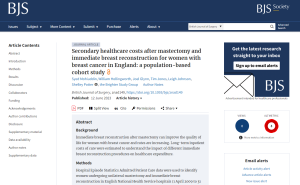Comparing the long-term costs of immediate breast reconstructions following mastectomy
13 June 2023
Abdominal free flap was the most expensive breast reconstruction option, according to research published in the British Journal of Surgery. This is despite this type of procedure being associated with lower revision and secondary reconstruction costs at a later stage.
Latissimus dorsi flap reconstruction with an implant, or the use of a tissue expander were associated with the lowest long-term costs. The latissimus dorsi is a muscle in the back that surgeons use to reconstruct a woman’s breast, while an abdominal flap is tissue taken from the stomach area for the same reason.
Researchers found that the lowest overall cost of inpatient care over three years was associated with implant-based procedures (latissimus dorsi flap with implant). Abdominal free flap reconstruction was the most expensive reconstructive option at this stage. It also remained the most expensive reconstruction option eight years after surgery. This was mainly due to the high cost of the initial procedure, even though the costs of revisions and secondary reconstructions were much lower than they were with other breast reconstruction procedure types.
Breast cancer is the most common type of cancer in women. Around 1 in 7 UK women will develop it in their lifetime. Despite advances in treatment and care, up to 40 per cent of women in the UK will have to have their breast removed (mastectomy).
A woman who undergoes a mastectomy can choose to have her breast reconstructed. This can happen at the same time as the mastectomy (immediate breast reconstruction) or at a later date. Different reconstruction procedures vary in how they impact patient well-being, recovery time and the potential need for more surgery in the future.
There are three main ways for a surgeon to reconstruct a breast. They can:
- Use an implant to replace all or some of a woman’s breast tissue
- Take tissue from another part of the body (autologous or “flap” reconstruction
- Use a woman’s own tissue and an implant
Researchers from the wider Brighter study compared the long-term costs of inpatient care for women who had undergone one-sided mastectomy and immediate breast reconstruction. To do this, they used routine healthcare cost data on a large nationally representative population-based cohort from England. In their assessment, they also included costs associated with any additional procedures that women needed to revise, replace or complete the reconstruction process. They reviewed these costs at three and eight years after the initial breast reconstruction procedure.
Dr Syed Mohiuddin, lead author, said:
“This study provides much needed data regarding the long-term secondary healthcare costs of the most common approaches to immediate breast reconstruction, but cost is only one of many considerations when evaluating different breast reconstruction options.
“To determine which type of breast reconstructions represents ‘value for money’, evidence on costs now need to be combined with key patient-reported outcomes such as patient satisfaction to inform decision-making.
“Although abdominal free flap was found to be the most expensive breast reconstruction option, if they result in better patient-centred outcomes that are maintained over time, they may represent a more cost-effective option than implants that were found to require more revisions and secondary reconstructions over time.”
Dr Tim Jones, a member of the study team, said:
“Rates of immediate breast reconstructions are increasing in the UK. Different procedure types vary in rates of short- and long-term complications, the need for revisions and secondary reconstructions as well as patient satisfaction with the outcomes of surgery.
“More research is needed to give policymakers and women access to high-quality evidence comparing the long-term costs and outcomes of implant-based and autologous breast reconstruction options to inform their decisions around healthcare.”
Paper
